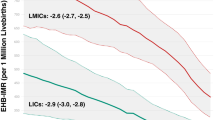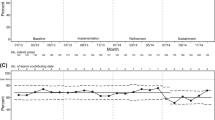Abstract
To address systems failures and promote a safer management of newborn jaundice, we propose an ‘aviation safety standard’ for newborn health-care services during the first week after birth. Systems failure in newborn jaundice management has been characterized by lapses in concern, loss of continuity, and delays in care by multiple providers at multiple sites. Components for a six-step national strategy to prevent severe neonatal hyperbilirubinemia and possibly kernicterus are being implemented as delineated in the 2004 AAP guidelines. The clinical guidelines for safer and evidence-based practice have been characterized by both healthcare and societal communities. Professional and community organizations are optimizing outreach resources and facilitating institutionalization of these practices. Nationwide implementation at individual birthing hospitals concurrent with surveillance feedback needs to be initiated. Implementation of a ‘six-sigma’ approach, as proposed to the current Center for Disease Control and Prevention-initiated partnership (health-care providers, public health and community advocates) may be achieved through collaboration with state and national agencies.
This is a preview of subscription content, access via your institution
Access options
Subscribe to this journal
Receive 12 print issues and online access
$259.00 per year
only $21.58 per issue
Buy this article
- Purchase on Springer Link
- Instant access to full article PDF
Prices may be subject to local taxes which are calculated during checkout



Similar content being viewed by others
References
Johnson LH, Brown AK, Bhutani VK . System-based approach to management of neonatal jaundice and prevention of kernicterus. J Pediatr 2002; 140: 396–403.
American Academy of Pediatrics. Subcommittee on Hyperbilirubinemia, Maisels MJ, Baltz RD, Bhutani VK, Newman TB, Palmer H, Rosenfeld W et al. Clinical Practice Guideline: Management of Hyperbilirubinemia in the Newborn Infant ⩾35 Weeks of Gestation. Pediatrics 2004; 114: 297–316. http://www.aappolicy.aappublications.org/cgi/content/full/pediatrics;114/1/297.
Bhutani VK, Johnson LH, Maisels MJ, Newman TB, Phibbs C, Stark AR et al. Kernicterus: epidemiological strategies for its prevention through systems-based approaches. J Perinatol 2004; 24 (10): 650–662.
Newman TB, Klebanoff MA . Neonatal hyperbilirubinemia and long-term outcome: another look at the Collaborative Perinatal Project. Pediatrics 1993; 92 (5): 651–657.
Newman TB, Xiong B, Gonzales VM, Escobar GJ . Prediction and prevention of extreme neonatal hyperbilirubinemia in a mature health maintenance organization. Arch Pediatr Adolesc Med 2000; 154: 1140–1147.
Ebbesen F . Recurrence of kernicterus in term and near-term infants in Denmark. Acta Paediatr 2000; 89: 1213.
Sheridan SE . Prevention of kernicterus and the parents of infants and children with kernicterus (PICK) organization. J Perinatol 2005; 25 (4): 227–228.
Kaplan M, Bromiker R, Schimmel MS, Algur N, Hammerman C . Evaluation of discharge management in the prediction of hyperbilirubinemia: the Jerusalem experience. J Pediatr 2007; 150: 412–417.
Manning DJ, Maxwell MJ, Todd PJ, Platt MJ . Prospective surveillance study of severe hyperbilirubinaemia in the newborn in the United Kingdom and Ireland. Arch Dis Child Fetal Neonatal Ed. Online publication. 0.1136/adc.2006.105361. http://fn.bmj.com/cgi/rapidpdf/adc.2006.105361v1.
Newman TB, Liljestrand P, Jeremy RJ, Ferriero DM, Wu YW, Hudes ES, et al., Jaundice and Infant Feeding Study Team. Outcomes among newborns with total serum bilirubin levels of 25 mg per deciliter or more. N Engl J Med 2006; 354 (18): 1889–1900.
Bhutani VK, Johnson LH, Schwoebel A, Gennaro S . A systems approach for neonatal hyperbilirubinemia in term and near-term newborns. J Obstet Gynecol Neonatal Nurs 2006; 35: 444–455.
Facchini FP, Mezzacappa MA, Rosa IR, Mezzacappa Filho F, Aranha-Netto A, Marba ST . Follow-up of neonatal jaundice in term and late premature newborns. J Pediatr (Rio J) 2007; 83 (4): 313–322.
Ip S, Chung M, Kulig J, O'Brien R, Sege R, Glicken S, et al. Subcommittee on Hyperbilirubinemia. An evidence-based review of important issues concerning neonatal hyperbilirubinemia. Pediatrics 2004; 114: e130–e153.
Lannon C, Stark AR . Closing the gap between guidelines and practice: ensuring safe and healthy beginnings. Pediatrics 2004; 114: 494–496.
Center for Disease Control and Prevention. Kernicterus/Newborn Jaundice. http://www.cdc.gov/ncbddd/dd/kernichome.htm.
Lazarus C, Avchen RN . Neonatal hyperbilirubinemia management: a model for change. J Perinatol 2009; 29(Suppl 1): S58–S60.
Eggert LD, Wiedmeier SE, Wilson J, Christensen RD . The effect of instituting a prehospital-discharge newborn bilirubin screening program in an 18-hospital health system. Pediatrics 2006; 117: e855–e862.
Ebbesen F, Andersson C, Verder H, Grytter C, Pedersen-Bjergaard L, Petersen JR et al. Extreme hyperbilirubinaemia in term and near-term infants in Denmark. Acta Paediatr 2005; 94: 59–64.
Sgro M, Campbell D, Shah V . Incidence and causes of severe neonatal hyperbilirubinemia in Canada. CMAJ 2006; 175: 587–590.
Lo SF, Doumas BT, Ashwood ER . College of American Pathologists. Bilirubin proficiency testing using specimens containing unconjugated bilirubin and human serum: results of a College of American Pathologists study. Arch Pathol Lab Med 2004; 128 (11): 1219–1223.
Author information
Authors and Affiliations
Corresponding author
Rights and permissions
About this article
Cite this article
Bhutani, V., Johnson, L. A proposal to prevent severe neonatal hyperbilirubinemia and kernicterus. J Perinatol 29 (Suppl 1), S61–S67 (2009). https://doi.org/10.1038/jp.2008.213
Published:
Issue Date:
DOI: https://doi.org/10.1038/jp.2008.213
Keywords
This article is cited by
-
End-tidal carbon monoxide and hemolysis
Journal of Perinatology (2014)
-
Universal bilirubin screening for severe neonatal hyperbilirubinemia
Journal of Perinatology (2010)



